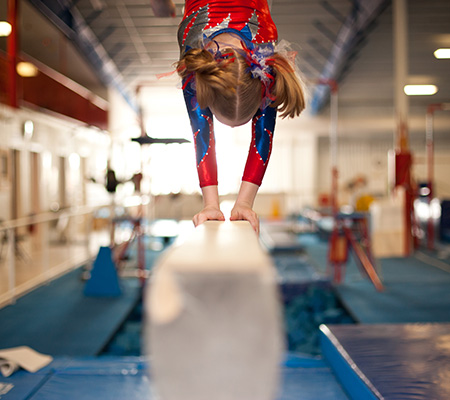
Gymnastics injuries are more likely to happen when athletes experience growth spurts.
Gymnastics is a physically and mentally demanding sport. It requires strength, coordination and concentration.
Besides improving strength and flexibility, gymnastics teaches athletes to excel individually and as part of a team. Gymnasts gain confidence as they learn challenging new skills.
Sometimes performing those thrilling flips and turns ends in pain. Gymnastics injuries can happen slowly or suddenly, said Dr. Jacob Lonsdale, a non-operative pediatric orthopedist at Marshfield Clinic.
Overuse injuries are common
Ripped skin on the palms is the most common ailment Kristi Kubs, a gymnastics coach and WIAA gymnastics judge, sees among athletes. However, more serious injuries can happen as gymnasts advance in the sport.
“If you’re a serious gymnast, participating more than 12 hours a week, there’s a good chance you’re going to experience an overuse or acute injury,” Lonsdale said.
Stress fractures are common among gymnasts because the sport involves frequent hard landings. They usually occur in the feet and lower legs but also can affect the spine. A stress fracture in the low back is called spondylolysis. Stress fractures in wrists and elbows can injure growing areas of the bones called growth plates.
Other overuse injuries that affect gymnasts include tendonitis and bursitis in the elbows and wrists.
Sprained ankles and broken toes are common acute injuries among gymnasts. Other fractures, ACL tears and traumatic tears to shoulder cartilage are less common but can happen.
“The majority of injuries I see happen among middle school athletes because growth spurts throw them off balance,” Kubs said.
Both overuse and acute injuries have potential for causing chronic pain and movement problems later in life.
Don’t play through the pain
A gymnast who has pain during a specific movement should rest or modify his or her activity for a few days. Pain that lasts longer than 2-4 days with rest is a sign of a possible overuse injury and should be checked by a health care provider.
Athletes diagnosed with overuse injuries should follow their provider’s plan for rest and recovery. Overuse injuries left untreated can become more serious.
Participating in other sports throughout the year that gives the wrists and ankles a break can reduce the likelihood of an overuse injury. That may not be possible for competitive gymnasts, so it’s important that serious athletes tell a coach or parent as soon as something starts to hurt.
Conditioning programs at many gyms take athletes through stretching and strengthening routines designed to prevent common injuries.
“Older gymnasts should spend more time stretching because they tend to get less limber as they get older,” Kubs said.
Choose a qualified instructor
“Choose a good instructor who knows what activities your child can perform safely according to his or her ability level,” Lonsdale said.
Instructors should make sure equipment is in good condition and insist gymnasts use supportive gear like ankle braces and wrist wraps when needed. Gymnasts should warm up before training. Always perform new or difficult skills with the help of a spotter.
The instructor should be willing to work with your child’s health care provider to help injuries heal.
Related Shine365 posts
Stress fractures: Aches you shouldn’t ignore
Why is my leg so sore? Avoid overuse injuries

